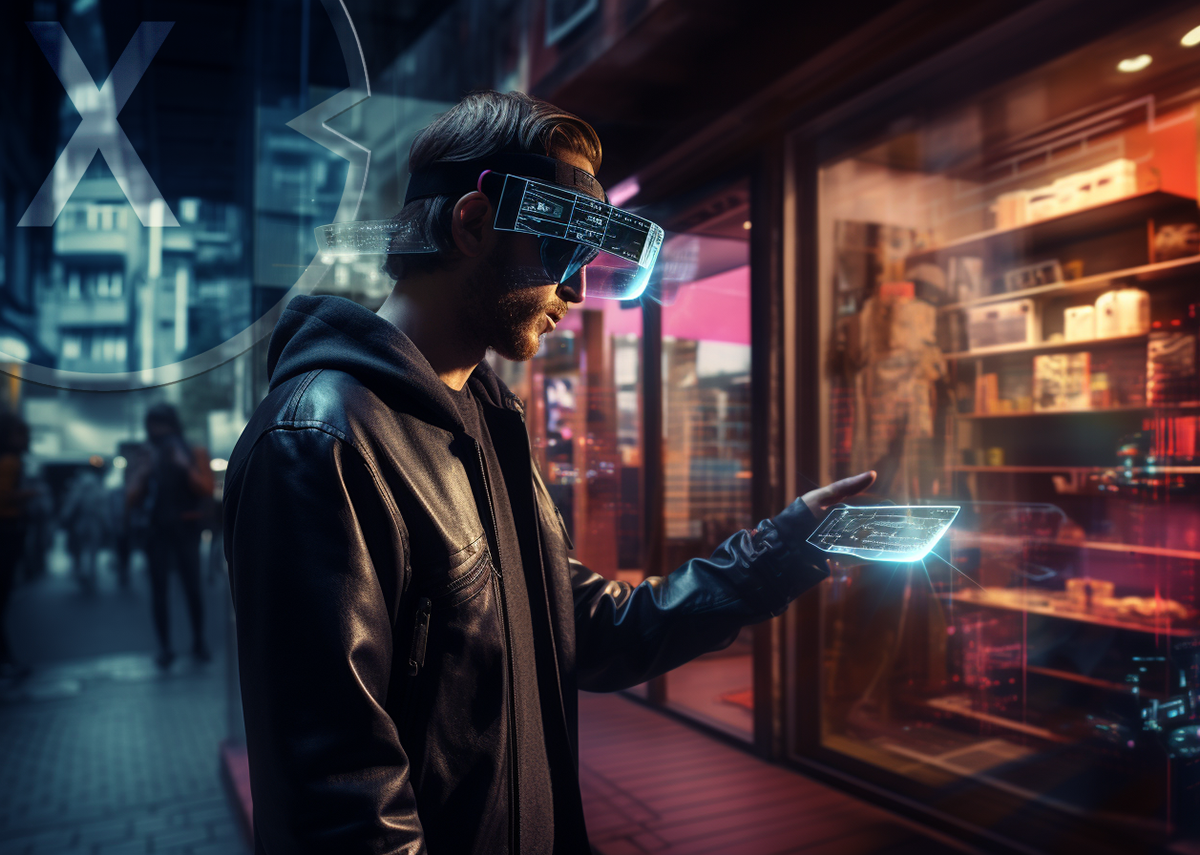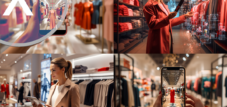
Customer Journey im (Extended Reality) XR-Zeitalter: Anpassung der Customer Journey an die Touchpoints – Bild: Xpert.Digital – AI & XR-3D-Rendering Machine (Kunstfoto/KI)
🚀 Die Customer Journey und ihr Wandel durch Extended Reality (XR)
Die Customer Journey, also die Reise eines Kunden von der ersten Wahrnehmung eines Produktes oder einer Dienstleistung bis hin zur Kaufentscheidung und darüber hinaus, wird durch die Einflüsse von Extended Reality (XR) revolutioniert. XR steht als Oberbegriff für alle immersiven Technologien, die die physische Realität erweitern, einschließlich Augmented Reality (AR) und Virtual Reality (VR). Diese Technologien bieten völlig neue Möglichkeiten zur Gestaltung von Kundenerfahrungen und erfordern eine entsprechende Anpassung der Customer Journey an die neuen Touchpoints.
👀 Die neue Rolle von Augmented Reality (AR) und Virtual Reality (VR) in der Customer Journey
AR fügt der realen Umgebung digitale Elemente hinzu, während VR eine vollständig künstliche Umgebung schafft. Beide Technologien ermöglichen es Unternehmen, Kunden auf innovative Weise anzusprechen und Interaktionen zu gestalten, die über traditionelle Schnittstellen hinausgehen.
Durch die Nutzung von AR können Kunden Produkte in ihrer realen Umgebung visualisieren, zunächst virtuell ausprobieren und so eine informiertere Kaufentscheidung treffen. Darüber hinaus schafft AR eine interaktive Plattform für personalisierte Werbeanzeigen und Produktplatzierungen, die sich nahtlos in das Nutzererlebnis integrieren lassen.
VR bietet eine noch intensivere Erfahrung, indem es Kunden ermöglicht, in eine vollständig künstliche, interaktive Welt einzutauchen. Diese reale Simulation kann genutzt werden, um Produkte oder Dienstleistungen auf eine Weise zu demonstrieren, die im physischen Raum entweder unmöglich oder unwirtschaftlich wäre.
🔄 Anpassung der Customer Journey Touchpoints in AR- und VR-Umgebungen
Eine effektive Customer Journey in AR- und VR-Umgebungen zu gestalten, bedeutet, die Interaktionspunkte (Touchpoints) sorgfältig zu überdenken und anzupassen. Die herkömmliche lineare Customer-Journey-Karte muss zu einem Netzwerk aus erweiterten Pfaden und Möglichkeiten entwickelt werden, die es dem Kunden ermöglichen, seine eigene Reise durch die angebotenen digitalen und physischen Welten zu gestalten.
🧭 Bewusstseinsphase
In der Bewusstseinsphase geht es darum, Aufmerksamkeit zu erregen und das Interesse des Konsumenten zu wecken. AR und VR können hier durch immersive Werbe- und Marketingkampagnen eingesetzt werden, die potenzielle Kunden nicht nur informieren, sondern auch unterhalten und engagieren. Beispielsweise können AR-Anwendungen die Umgebung des Nutzers verändern oder erweitern, was für ein überraschendes und denkwürdiges Markenerlebnis sorgen kann.
💡 Erwägungsphase
Wenn ein Kunde erwägt, ein Produkt zu kaufen oder eine Dienstleistung in Anspruch zu nehmen, sucht er nach vertiefenden Informationen. AR und VR können hier dazu dienen, dem Kunden detaillierte Einblicke und Erlebnisse anzubieten, die weit über Fotos und Beschreibungen hinausgehen. Zum Beispiel können Kunden mithilfe von VR in virtuellen Showrooms Autos erkunden, sie von allen Seiten betrachten und sich sogar ans Steuer setzen. AR kann die Features eines Smartphones direkt auf dem eigenen Gerät simulieren und dem Kunden somit eine praktische Erfahrung bieten.
🛒 Kaufphase
In der Kaufphase wird die Entscheidung getroffen. AR und VR können diese Phase durch vereinfachte und verbesserte Kaufprozesse transformieren. Stellen Sie sich vor, Sie verwenden VR, um einen virtuellen Laden zu betreten, in dem Sie Produkte genau betrachten, vergleichen und sogar ausprobieren können. AR kann eine visuelle Darstellung bieten, wie ein Möbelstück in einem bestehenden Raum aussehen würde.
🔧 Nutzungsphase
Nach dem Kauf geht die Reise weiter. Hier können AR und VR dem Kunden helfen, das gekaufte Produkt besser zu nutzen. Anleitungen, die durch AR visuell unterstützt werden, können dem Nutzer helfen, ein Gerät effektiver einzusetzen oder Probleme selbst zu lösen. VR kann genutzt werden, um fortgeschrittene Schulungen und Kurse anzubieten, ohne dass der Kunde seinen Standort verlassen muss.
❤️ Loyalitätsphase
Um eine langfristige Kundenbindung zu erreichen, müssen Unternehmen auch nach dem Kauf eine Beziehung zum Kunden pflegen. AR- und VR-Technologien können personalisierte After-Sales-Services bieten, wie etwa virtuelle Treffen oder Produktanpassungen, die der Kunde selbst in einer AR-Umgebung vornehmen kann.
🚧 Herausforderungen und Chancen bei der Integration von AR und VR in die Customer Journey
Während AR und VR enorme Möglichkeiten bieten, sind sie auch mit Herausforderungen verbunden. Technische Hürden, wie mangelnde Benutzerfreundlichkeit, hohe Kosten und fehlende Standardisierung, müssen überwunden werden. Datenschutz ist eine weitere wichtige Überlegung, da immersive Technologien oft sensible Benutzerdaten erfassen und verarbeiten.
Gleichzeitig öffnen AR und VR neue Kanäle für Datenanalysen und Kundenfeedback, die Unternehmen helfen können, ihre Angebote zu verfeinern und personalisierter zu gestalten. Indem Unternehmen lernen, diese Rückmeldungen effektiv zu nutzen, können sie die Customer Journey iterativ verbessern und so die Kundenbindung und -zufriedenheit steigern.
📈 Customer Journey im XR-Zeitalter ist dynamisch
Die Customer Journey im XR-Zeitalter ist dynamisch, vielschichtig und bietet ein beispielloses Niveau der Kundeninteraktion. Unternehmen, die AR und VR strategisch in ihre Customer Journey integrieren, können die Kundenerfahrung verbessern, die Kaufentscheidung erleichtern und letztlich die Kundenbindung festigen. Der Schlüssel zum Erfolg liegt jedoch nicht allein in der Technologie, sondern vielmehr in der Fähigkeit, diese in wertsteigernde Erlebnisse zu transformieren, die eng mit den Bedürfnissen und Erwartungen der Kunden verwoben sind.
👤 Personalisierung und Interaktivität
AR und VR eröffnen neue Wege, um die Reise des Kunden persönlich und interaktiv zu gestalten. Eine personalisierte Customer Journey, die auf individuellen Daten und Vorlieben des Kunden basiert, kann durch AR- und VR-Technologien auf ein neues Level gehoben werden. Kunden können beispielsweise durch virtuelle Räume geführt werden, die auf ihre Interessen zugeschnitten sind, oder sie können durch AR in Echtzeit Empfehlungen erhalten, die auf ihrem Aufenthaltsort und ihren früheren Interaktionen beruhen.
🔗 Integration in bestehende Ökosysteme
Für ein nahtloses Kundenerlebnis ist es entscheidend, dass AR- und VR-Erlebnisse in die bestehenden digitalen Ökosysteme der Unternehmen integriert werden. Dazu gehört auch die Verknüpfung mit anderen Kanälen wie dem Online-Shop, sozialen Medien oder dem Kundenservice. Eine effektive Integration ermöglicht es dem Kunden, unabhängig vom Kanal, einen kohärenten und kontinuierlichen Dialog mit der Marke zu führen.
🔮 Ausblick und zukünftige Entwicklung
Die Zukunft der Customer Journey in AR- und VR-Umgebungen erscheint grenzenlos. Mit Fortschritten in Technologie wie 5G, KI und Machine Learning werden die Erlebnisse noch reicher, realitätsnäher und nahtloser. Es wird erwartet, dass durch die Verbesserung der Technologien auch die Zugänglichkeit und Akzeptanz beim Verbraucher steigt. Für Unternehmen bedeutet dies, dass sie die Entwicklung dieser Technologien genau beobachten und ihre Strategien stetig anpassen sollten, um wettbewerbsfähig zu bleiben.
Unternehmen stehen vor der Herausforderung, AR und VR so einzusetzen, dass sie einen echten Mehrwert für den Kunden schaffen und keinem Selbstzweck dienen. Die Technologien müssen sinnvoll in die Gesamtstrategie eingebunden werden, um die Customer Journey zu bereichern, anstatt sie zu komplizieren.
Innovationen wie räumliches Computing, bei dem XR-Umgebungen noch intuitiver und natürlicher navigiert werden können, werden die Art und Weise, wie Kunden mit Marken interagieren, weiter verändern. Die zukünftige Customer Journey könnte komplett in einem virtuellen Raum stattfinden, der reich an multisensorischen Erlebnissen ist.
🤔 Marketing- und Vertriebsteams müssen umdenken
Das XR-Zeitalter bietet atemberaubende Möglichkeiten, die Interaktion zwischen Kunden und Marken neu zu gestalten. Unternehmen, die es verstehen, ihre Customer Journey durch den Einsatz von AR und VR zu differenzieren und zu verbessern, werden tiefergehende und beständigere Beziehungen zu ihren Kunden aufbauen. Es erfordert jedoch kreative Ansätze, technisches Know-how und ein grundlegendes Verständnis der Bedürfnisse und Wünsche der Kunden.
In dieser neuen Ära müssen Marketing- und Vertriebsteams umdenken, sich kontinuierlich weiterbilden und flexibel auf die Veränderungen im Verbraucherverhalten reagieren. Erfolg werden jene Unternehmen haben, die ihre Kunden wirklich verstehen und in der Lage sind, ihnen durch den Einsatz von AR und VR unvergleichliche Erlebnisse zu bieten, die sie faszinieren, binden und letztlich zu loyalen Botschaftern ihrer Marke machen.
📣 Ähnliche Themen
- 🌟 Augmented und Virtual Reality: Die Zukunft der Customer Journey
- 💥 Revolution der Customer Journey: Wie XR die Kundenerfahrung verändert
- 🌍 Kundenerfahrungen im Wandel: AR und VR für die Customer Journey
- 🚀 Neue Möglichkeiten für Kundeninteraktion: AR und VR in der Customer Journey
- 🤝 Die Integration von AR und VR in die Customer Journey: Chancen und Herausforderungen
- 💡 Interaktive Touchpoints: AR und VR für eine personalisierte Customer Journey
- 🎯 Die Customer Journey im XR-Zeitalter: Personalisierung und Interaktivität
- 🔗 Nahtlose Integration: AR und VR in bestehende Ökosysteme der Customer Journey
- 🌐 Zukunftsausblick: Die Weiterentwicklung der Customer Journey mit AR und VR
- 🔄 Umdenken im Marketing und Vertrieb: Die Interaktion mit Kunden im XR-Zeitalter
#️⃣ Hashtags: Kundenerlebnis, Marketing, CustomerJourney, ExtendedReality, ARundVR
🎯🎯🎯 Profitieren Sie von der umfangreichen, fünffachen Expertise von Xpert.Digital in einem umfassenden Servicepaket | BD, R&D, XR, PR & Digitale Sichtbarkeitsoptimierung
Profitieren Sie von der umfangreichen, fünffachen Expertise von Xpert.Digital in einem umfassenden Servicepaket | R&D, XR, PR & Digitale Sichtbarkeitsoptimierung - Bild: Xpert.Digital
Xpert.Digital verfügt über tiefgehendes Wissen in verschiedenen Branchen. Dies erlaubt es uns, maßgeschneiderte Strategien zu entwickeln, die exakt auf die Anforderungen und Herausforderungen Ihres spezifischen Marktsegments zugeschnitten sind. Indem wir kontinuierlich Markttrends analysieren und Branchenentwicklungen verfolgen, können wir vorausschauend agieren und innovative Lösungen anbieten. Durch die Kombination aus Erfahrung und Wissen generieren wir einen Mehrwert und verschaffen unseren Kunden einen entscheidenden Wettbewerbsvorteil.
Mehr dazu hier:
🗒️ Xpert.Digital: Ein Pionier im Bereich der Extended und Augmented Reality
🗒️ Die richtige Metaverse Agentur und Planungsbüro wie Beratungsfirma finden – Suche und gesucht Top Ten Tipps für Beratung & Planung
Mehr dazu hier:
Wir sind für Sie da - Beratung - Planung - Umsetzung - Projektmanagement
Xpert.Digital - Pioneer Business Development
Smart Glasses & KI - XR/AR/VR/MR Branchenexperte
Consumer Metaverse oder Metaverse im Allgemeinen
Bei Fragen, weiteren Informationen und Beratungsbedarf dürfen Sie sich gerne jederzeit an mich wenden.
Gerne stehe ich Ihnen als persönlicher Berater zur Verfügung.
Sie können mit mir Kontakt aufnehmen, indem Sie unten das Kontaktformular ausfüllen oder rufen Sie mich einfach unter +49 89 89 674 804 (München) an.
Ich freue mich auf unser gemeinsames Projekt.
Xpert.Digital - Konrad Wolfenstein
Xpert.Digital ist ein Hub für die Industrie mit den Schwerpunkten, Digitalisierung, Maschinenbau, Logistik/Intralogistik und Photovoltaik.
Mit unserer 360° Business Development Lösung unterstützen wir namhafte Unternehmen vom New Business bis After Sales.
Market Intelligence, Smarketing, Marketing Automation, Content Development, PR, Mail Campaigns, Personalized Social Media und Lead Nurturing sind ein Teil unserer digitalen Werkzeuge.
Mehr finden Sie unter: www.xpert.digital - www.xpert.solar - www.xpert.plus

